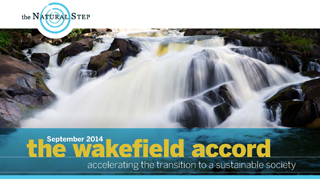Tim’s Top 4 Characteristics of Innovation Ecosystems
 Last fall, The Natural Step gathered a group of Canadian leaders in sustainability and social innovation in Wakefield, Quebec. Surrounded by the turbulent beauty of the MacLaren Falls we came to share experiences and resources, and to address the need for a qualitatively different approach to the way we work.
Last fall, The Natural Step gathered a group of Canadian leaders in sustainability and social innovation in Wakefield, Quebec. Surrounded by the turbulent beauty of the MacLaren Falls we came to share experiences and resources, and to address the need for a qualitatively different approach to the way we work.
We affirmed our commitment that to affect change greater than our individual mandates, we need many more points of connectivity into the very systems we are trying to shift. In order to identify the sort of strategic interventions that lead to breakthrough outcomes we need to be informed by a depth of understanding that can only be acquired through diverse and sometimes uncomfortable alliances.
It is extremely difficult to create artificial processes that generate trusted relationships, but in an ecosystem of innovation, such cross-sector and cross-silo collaboration become the norm.
‘How will we know we are part of an ecosystem of innovation?’ is one of the questions Wakefield participant and TNS Director of Strategic Communications Delyse Sylvester, asked Tim Draimin, Executive Director of Social Innovation Generation (SiG) - a leading advocate for networks that move beyond collaboration as a transaction, to an opportunity of distributed reward and reciprocity.
Distilled from this conversation are Tim’s top four characteristics that define ecosystems of innovation. They are networks where:
- Diversity is prized. More diverse actors are capable of generating more disruptive innovation than people of like thinking. Many different players need to be brought into alignment for social innovations to have their sought-after impact. If organizations and individuals are incapable of reaching out and involving other sectors, then they will dramatically limit the scale of what they can achieve. An ecosystem of innovation is one in which diversity is embraced.
- Enablers create habitat. The potential for innovation is dramatically enhanced if there are supports for how people and organizations are able to connect. If it is difficult for individuals or organizations to find others to help them achieve their goals, the chance of success will be slim. In an innovation ecosystem friction is reduced to allow terrain to expand beyond rigid boundaries.
- Connectors are keystones. Innovation ecosystems are spaces where helping to promote social capital and connections among disparate players is valued. Those who create situations in which others can meet and develop relationships are recognized as the leaders they are, and are able to bank and draw upon social capital when opportunities to achieve really significant systems change present themselves.
- Relationships unlock systems: In an innovation ecosystem it is easier for players to overcome differences that stem from siloed thinking and the modes of acting they’ve become attached to internally. Individuals can reach a different plateau of agreement and partnership in pursuit of a common goal when collaboration moves at the speed of trust.
 Tim’s character compass is a very helpful guide for orienting the movement to engage outsiders as collaborators. And timely, given that Wakefield represents a new step forward for TNS into a role of helping catalyze a shared community of practice among fellow sustainability change agents. The diversity of organizations represented included the Pembina Institute, Forum for the Future, Reos Partners, Suncor Energy Foundation, SiG, the Ivey Foundation, the J.W. McConnell Family Foundation, the, Volans, Sustainability CoLab, Speck Consulting, Sustainability Prosperity, and Social Currents. Organizations from different sectors, sharing similar challenges of transitioning systems to what the future requires of us.
Tim’s character compass is a very helpful guide for orienting the movement to engage outsiders as collaborators. And timely, given that Wakefield represents a new step forward for TNS into a role of helping catalyze a shared community of practice among fellow sustainability change agents. The diversity of organizations represented included the Pembina Institute, Forum for the Future, Reos Partners, Suncor Energy Foundation, SiG, the Ivey Foundation, the J.W. McConnell Family Foundation, the, Volans, Sustainability CoLab, Speck Consulting, Sustainability Prosperity, and Social Currents. Organizations from different sectors, sharing similar challenges of transitioning systems to what the future requires of us.
This collective promise to share knowledge, support each other, and collaborate led to drafting The Wakefield Accord.
Tim believes the Wakefield gathering was a key moment in the development of an innovation ecosystem here in Canada; a place where some of the early groundwork was laid. He challenges us to continue to develop system-wide stakeholder relationships and new collaborative platforms such as the Energy Futures Lab to generate transformational results that have the potential to shift systems.
- Log in to post comments

